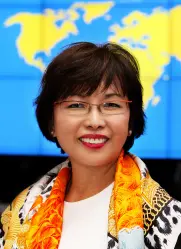Educating a girl is one of the best investments her
family, community, and country can make. We know
that a good quality education can be life-changing for
girls, boys, young women, and men, helping them develop
to their full potential and putting them on a path
for success in their life. We also know that educating
a girl in particular can kick-start a virtuous circle of
development. More educated girls, for example, marry
later, have healthier children, earn more money that
they invest back into their families and communities,
and play more active roles in leading their communities
and countries.
Over the last 25 years, there have been large gains
in girls’ education, and we as a global community can
congratulate ourselves for the real progress that has
been made. This demonstrates that with shared goals
and collective action—among governments, international
organizations, civil society, media, and the private
sector—we can change the educational prospects
for girls around the world.
Despite this progress, our research shows that there
are hotspots in the world where girls are not getting
a quality education. While there certainly are places
where boys are behind, we have focused on understanding
how and where across the world girls are behind.
The message is that many countries have work
to do to improve girls’ education, whether related to
the gender gap in primary or secondary enrollment
or learning.
There are about 80 countries where progress on girls’
education has stalled. These countries are not meeting
the education Millennium Development Goals.
They are stuck in an education bog—still struggling to
enroll all girls and boys in primary school and close
the gender gaps between boys and girls at both the
primary and secondary levels.
Quality learning is important for the future lives of girls and boys, but it is also an especially important ingredient in the virtuous circle of development that comes from girls’ education.
There are an additional
30 countries that have successfully enrolled girls and
boys in primary and secondary education but are
trapped in low-quality learning. They are struggling to
ensure that girls and boys master foundational skills
such as basic literacy, numeracy, and science concepts.
Quality learning is important for the future lives
of girls and boys, but it is also an especially important
ingredient in the virtuous circle of development that
comes from girls’ education. Finally, there are another
30 countries where children are successfully enrolled
and learning. However, girls are behind boys in math.
In some ways, we can think of girls in these countries
bumping up against an educational glass ceiling.
In this report, we review in detail the progress in girls’
education, the work that remains to be done, and strategies
for success. Governments, international development
agencies, and civil society organizations have
supported a variety of programs that have made a
difference in both large and small ways. There are valuable
lessons to learn from them—but more progress is
needed, especially in the poorest countries and among
the disadvantaged populations in most countries.
Ultimately we recommend renewed collective action
for advancing girls’ education in hotspots around the
world, especially in the 80 countries where progress on
girls’ education has stalled. We recognize the powerful
contribution that girls and women themselves can
make to achieve this. Our first recommendation is to lean in with girls’ and women’s leadership by investing
in two initiatives that could go to scale in a short
time frame and rally support from a range of actors,
especially civil society and the private sector. The first
initiative aims to build strong girl and women leaders
by cultivating their skills and capacities to be agents
of their own lives. The second initiative aims to put
girls and women at the center of a data revolution
on gender, one that would fill the critical information
gaps about their status, what support they need to
succeed, and which interventions have been the most
and the least effective. Throughout the world today, it
is possible to put mobile technology to work catalyzing
a major girl-generated big data initiative.
The Brookings Institution is committed to quality, independence, and impact.
We are supported by a diverse array of funders. In line with our values and policies, each Brookings publication represents the sole views of its author(s).













